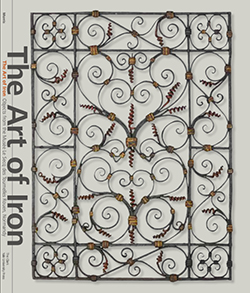
June 9–September 16, 2018
LOCKS AND LECTERNS
Strong Box
German (Nuremberg)
18th century
Rolled iron, ornamented with wrought iron, cut and chisel-finished
Réunion des Musées Métropolitains, Rouen, Normandy, LS.2010.6.2a
© Agence La Belle Vie – Nathalie Landry
Master craftsmen in early modern Europe often specialized in particular aspects of metalwork. The serrurier, or locksmith, is one key example. These artisans needed skills not only in crafting objects of superior design and decoration, but also in the demanding area of high-value security. Locks and lockboxes were essential to the preservation of wealth in times before the emergence of banks, when much mutable personal wealth was represented by material objects made of silver or gold, along with jewels and property deeds. Strong and tamper-resistant locking devices were vital to home security and the protection of valuable assets, so it is no wonder that a highly specialized profession emerged around these challenges.
The Musée Le Secq des Tournelles has a spectacular collection of keys, locks, and lockboxes, all examples of the delicate and challenging art of the locksmith. Makers of such objects used finely crafted steel as well as wrought iron in the intricate mechanisms, and often ornamented their works with polished and pierced brass or bronze fittings that provided beauty and luster to wealthy home interiors. While craftsmen in France and England were known for the production of high-quality locks and keys that could secure homes, rooms, or wardrobes, artisans in Germany specialized in the production of large lockboxes that could act as small in-house safes. The exuberant decoration of a remarkable lockbox in this exhibition manifests not only the inventiveness of the locksmith behind it in creating a secure container, but also the owner’s wealth and taste. A hidden keyhole on the cover of this chest enabled the owner to turn the custom-fitted key, which simultaneously operates eighteen bolts securing the cover to the box. A ratcheted support allows the lid to be propped open at one of many positions as the contents of the box are accessed.
Other specialized productions in wrought iron included magnificent furnishings for palatial or chapel interiors. The Art of Iron features two ecclesiastical lecterns, both intended to reflect the splendor and solemnity of the church interiors for which they were made.
The catalogue for The Art of Iron includes essays by Kathleen M. Morris, the Clark Art Institute curator of decorative arts, and by the Musée Le Secq’s former and current curators, Anne-Charlotte Cathelineau and Alexandra Bosc. Softcover, 112 pages. Distributed by Yale University Press. Call the Museum Store at 413 458 0520 to order.


